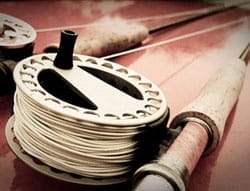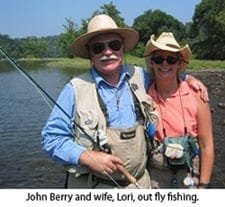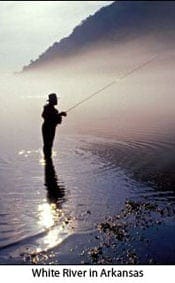 I received a new fly fishing catalogue in the mail yesterday that featured no less than 14 different brands of fly rods. For each brand there were dozens of different models, lengths, weights and numbers of pieces. I wondered to myself how any new or even experienced anglers could make a decision with so many options. Of all of the decisions facing the fly fisher, this is easily the most complicated. With the cost of some rods exceeding several thousand dollars, making the wrong decision can be an expensive mistake. There are a lot of criteria to consider.
I received a new fly fishing catalogue in the mail yesterday that featured no less than 14 different brands of fly rods. For each brand there were dozens of different models, lengths, weights and numbers of pieces. I wondered to myself how any new or even experienced anglers could make a decision with so many options. Of all of the decisions facing the fly fisher, this is easily the most complicated. With the cost of some rods exceeding several thousand dollars, making the wrong decision can be an expensive mistake. There are a lot of criteria to consider.
It all starts with a simple decision- what you will be fishing for. The rod you need for largemouth bass is quite different from the rod you need to fish for small brook trout in high mountain streams. It is not the size of the fish you expect to catch but the size of the fly you will be casting and where you will be casting it.
Fly rods are made from three basic materials. The traditional choice is bamboo. Made from planed triangular sections of split bamboo carefully glued and wrapped together, these rods are individual works of art. Since they are handmade and labor intensive, they can be very expensive. They are a bit heavy, feature a soft action and require regular maintenance. I own an antique one that I use to fish for native brookies in the Smokies. Fiberglass rods replaced the bamboo rods in the 1950s. They were less expensive but were still heavy and maintained the softer action of bamboo. They are still manufactured and have their fans, but for the most part, they have been replaced by graphite rods. Today, the most popular material for fly rods is graphite. A byproduct of the space race, it is lighter, more responsive and can be formulated to provide slow or fast actions.
 A slow action rod will bend lower in the blank towards the handle. It will generate less line speed and will roll cast well. The slow action rod will be more forgiving when casting and will bend easily protecting light tippets in the process. They cast well at short distances and are suitable for fishing dry flies. A fast action is stiffer and will bend closer to the tip of the rod. It generates more line speed and allows you to cast further. The timing on a fast rod is more critical, and it will not protect small tippets. You would use this action for casting streamers or fishing grasshoppers. A medium fast action is a compromise between a slow action and a fast action. Personally, I prefer a slow action rod and my wife, Lori, prefers a fast action rod.
A slow action rod will bend lower in the blank towards the handle. It will generate less line speed and will roll cast well. The slow action rod will be more forgiving when casting and will bend easily protecting light tippets in the process. They cast well at short distances and are suitable for fishing dry flies. A fast action is stiffer and will bend closer to the tip of the rod. It generates more line speed and allows you to cast further. The timing on a fast rod is more critical, and it will not protect small tippets. You would use this action for casting streamers or fishing grasshoppers. A medium fast action is a compromise between a slow action and a fast action. Personally, I prefer a slow action rod and my wife, Lori, prefers a fast action rod.
The weight of a rod signifies its ability to cast a fly line of a given weight. The weight of a line is determined by the weight of the first thirty feet of the line in grains (as specified by the American Sportfishing Association). The first thirty feet of a five weight fly line is 160 grains. Fly line weights vary from 0 to 14 with 14 being the heaviest. A 0 weight fly line could cast a tiny fly and a 14 weight fly line could cast a huge fly. When I am wade fishing, I use a four weight as it easily casts the small flies we fish here. When I am fishing from a boat I generally use a five weight because I fish larger flies in heavy water. When I am fishing for smallmouth, I use a seven weight to cast the big Clouser minnows or crayfish imitations. I use an eight weight to throw huge hair bugs at largemouth bass.
The length of a fly rod can vary greatly. The standard one handed fly rod can range from as short as six feet to ten feet. While a two handed Spey rod can be fourteen feet or longer. Though there are a few local anglers that have and fish with Spey rods, the norm here is the conventional one handed rod. A short rod is best in tiny mountain streams that have a lot of overhanging trees and tight casting conditions (similar to Dry Run Creek). A longer rod can generate more line speed and cast further. The extra length is also an advantage when mending line. The norm for fly rods here is nine feet with a few anglers opting for ten foot rods. A longer rod will be a bit heavier than a short rod. I fish a seven foot rod in the Smokies and a nine footer here.
 You can buy fly rods that have a varied number of pieces. There are two piece rods, three piece rods, four piece rods, five piece rods, etc. The more pieces, the shorter the length of the individual pieces and the shorter the rod tube that they will fit into. A four piece rod will easily fit into a standard duffle bag making them perfect for travel. A six piece rod can fit into a brief case or motorcycle saddle bag. I actually do most of my fishing with an old two piece that fits easily in my ancient Volvo station wagon. However, I must add that all of the rods that I have purchased for my own use in the last twenty years have been four piece rods. They are just easier to travel with. A few years ago, the trend was for the major manufacturers to make three piece rods. I always thought that they were not a good idea because when broken down they could not fit in most luggage. I thought that they presented no size advantage over two piece rods.
You can buy fly rods that have a varied number of pieces. There are two piece rods, three piece rods, four piece rods, five piece rods, etc. The more pieces, the shorter the length of the individual pieces and the shorter the rod tube that they will fit into. A four piece rod will easily fit into a standard duffle bag making them perfect for travel. A six piece rod can fit into a brief case or motorcycle saddle bag. I actually do most of my fishing with an old two piece that fits easily in my ancient Volvo station wagon. However, I must add that all of the rods that I have purchased for my own use in the last twenty years have been four piece rods. They are just easier to travel with. A few years ago, the trend was for the major manufacturers to make three piece rods. I always thought that they were not a good idea because when broken down they could not fit in most luggage. I thought that they presented no size advantage over two piece rods.
Finally, there is the cost. I have not been able to make a direct correlation between cost and casting quality. That does not mean that I do not own any expensive rods. The top quality rods we have today are handmade in the United States and the least expensive ones are made offshore. The more expensive rods are more carefully finished and just look a bit nicer.
My recommendation is that you think about how you will fish and consider all of the variables. Go to your local fly shop. Cast many different rods until you find one that meets your needs and feels just right.



